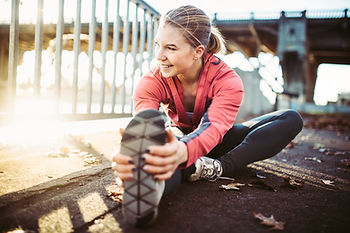
The Distance
Blog
Running in Colder Temperatures
Running in the cold is a necessary evil for all of those runners who wish to continue improving their times. It's important to know what your body is experiencing and going through on those cold runs.
Do you ever wonder why last week when it was fifty degrees you could finish your six mile run in forty-eight minutes, but when you run six miles two weeks ;later on the same route in thirty degrees, it took you fifty-three minutes? Do you ever wonder why your fingers and toes feel numb, even though you wore your thickest pair of gloves and warmest pair of socks? Or why your nose just won't stop running? Why is it that my winter runs seem so much harder? DId you know that you're metabolic rate increases and you are able to burn more calories on your colder runs since your body is working twice as hard to keep warm?

In an article published on Runner's World, Alison Wade stated, "Exercising in the cold might reduce your body’s immune function, which could make you more susceptible to illness, according to research published in PLoS ONE." The reason you find your nose running during your colder runs is because your nose is trying to relieve the dryness that the cold air brings because the cold air lacks humidity and moisture. The lack of humidity and moisture in the air also causes the burning sensation you feel in your lunges. You know that feeling you get in your fingers and toes. It comes from "your blood vessels constricting in response to the cold air." Less of your blood is going to your toes and fingers, and instead is going to the center of your body and your more important organs, such as your heart.
You know how your colder runs feel harder than your runs, in say, sixty or seventy degrees? This is not only because of snow, ice, and the ten extra layers you've thrown on, but because in temperatures below freezing your body is having to work twice as hard to keep your core temperature from freezing as well. The good news is that the colder temperatures "increase your metabolic rate and calorie burning abilities."

If your muscles feel even tighter than usual during or after your run, this is because "they can't contract as efficiently in colder temperatures." There is less oxygen that can be released from your hemoglobin, the protein molecule found in red blood cells that is responsible for transporting oxygen from your lunges to your body's tissues, making less oxygen available to your muscles, leaving them feeling tighter than usual. To help them feel less tight, don't warm up inside. It's better to warm up in the same temperatures you'll be running in. This is because after you warm-up and stretch inside your muscles are warm and less tight, so when you go outside to run, your muscles just tighten up again, making it much harder to loosen your muscles up again.
TIPS FOR RUNNING IN THE COLD:
-
Layer your clothing- Although you may think that wearing one warm layer is a good idea, it's better to wear two or three, or more depending on how cold it is, layers that are lighter. This is because the different layers can trap heat better, helping to keep you warmer. Wearing one layer that is heavy will only slow you down and make you feel heavier.
-
Invest in a scarf or something to cover your mouth, and probably your nose too- You'll want to cover your mouth and nose so it can warm the air before you breathe it in.
-
Cover your eyes- Remember when your eyes would water and you'd start to cry because the air is just that cold that you can't help it? Wearing sunglasses or googles can help with that. Sunglasses are also helpful on those bright snowy days where the sun can reflect off of the snow and feel like it's blinding you.
-
Warm up before you run- As mentioned before, warming up when it's colder outside is a little more important to do than when it's warmer out because your muscles are going to be tighter. Warm up and stretch in the same temperatures and environment you'll be running in so your muscles won't tighten up right after you go outside.
-
Be safe- If you're running in the dark, make sure you have reflectors on. If something starts to feel weird or off, going inside and running on the dreaded treadmill might be a good idea.
CITATIONS:
Veling, J. (2015, December 08). What Happens to Your Body During a Winter Run. Retrieved January 12, 2018, from https://www.active.com/running/articles/what-happens-to-your-body-during-a-winter-run
A. (2017, September 20). What Happens to Your Body When You Run in the Cold. Retrieved January 12, 2018, from https://caloriebee.com/workout-routines/What-Happens-to-Your-Body-When-You-Run-in-the-Cold